Is it a small loon?
Is it a lost penguin?
No, it’s a Common Murre!
Common Murres (Uria aalge) are duck sized seabirds commonly found along the entire coast of western North America. Breeding adults have black backs, throats, and heads with white undersides like penguins. They also have long, slender, pointed bills like loons… you may see how people get confused! (All About Birds, 2015). One very distinctive feature of the Common Murre is their call. An untrained ear may think that a dying cat was being trodden on by a untuned accordion, but that would be incorrect. Please enjoy a sample of this distinctive sound below:
Squeals of chicks and trumpets of adult Common Murres
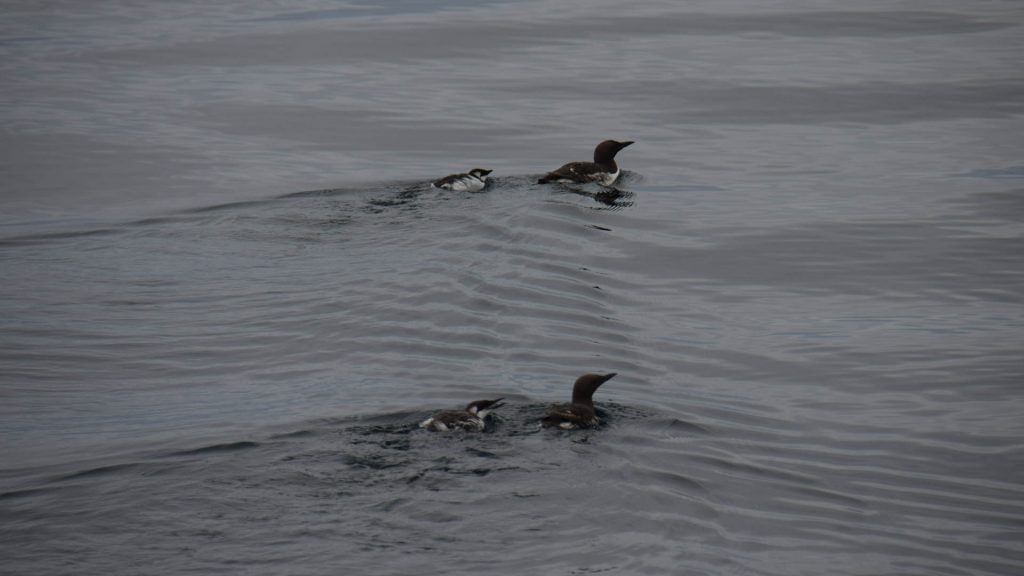
Two adult Common Murres with their chicks. Note the solid black back and head of the adults contrasted with the white colouration of the chicks. Image by Alex McDonald. Property of Stubbs Island Whale Watching.
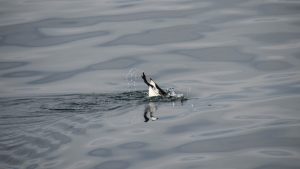
The less commonly observed side of a Common Murre… also the most entertaining picture to capture. Photo by Alex McDonald. Property of Stubbs Island Whale Watching
They are not a sexually dimorphic species, so the males and females look the same. Males can weigh slightly more than females (about 5%) depending on the time of year (Cameron-MacMillan et al., 2007) Non breeding adults and juveniles have a white face and throat, distinguishing them from the breeding population. They belong to the Order Charadriiformes in the Family Alcidae along with other recognizable wing-propelled diving seabirds such as Guillemots, Murrelets, Auklets and the charismatic Puffins (All About Birds, 2015).
Common Murre are widespread and numerous but like most seabirds, they are vulnerable to oil spills and gill netting (All About Birds, 2015). The North American Waterbird Conservation plan estimated that the North American population was at 4,250,000 in 2002 (Kushlan et al., 2002).
Common Murres spend most of their time on the water, along rocky coastlines such as Vancouver Island, where they are found year round. They are expert swimmers and divers, reaching astounding depths in order to forage for fish, squid and other marine invertebrates (All About Birds, 2015). Check out my other blog post (I Believe I Can Fly (Underwater)!) for even more information on these superstar divers! Common Murres sit upright on sea cliffs when not on the water, further confusing people who are certain that penguins are not found in the Northern Hemisphere.
Along rocky coastlines are also where they nest. They nest in enormous colonies on cliff ledges and flat stony surfaces, laying their eggs in shallow depressions on the bare rock (Harding et al., 2007). They do not build a nest for their eggs, instead they have thick eggshells to prevent egg loss and breakage (Pirie-Hay and Bond, 2014).
The eggs are very pointed at one end and the shell is thicker on the pointy end. This shape is adapted to help prevent the egg from rolling along the rock and off the cliff ledge (Pirie-Hay and Bond, 2014). Instead when pushed, the egg rolls around in a circle. The eggs are highly colour variable, ranging from white to tan with no markings, to dark green or turquoise with black spots. This variation may allow parents to recognize their own eggs when they come back from feeding, which is important because they nest in such huge colonies and could easily mistake another egg for their own otherwise (All About Birds, 2015).
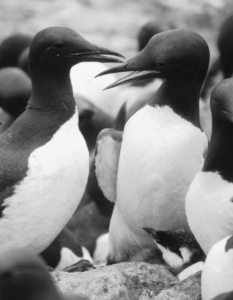
A Common Murre couple and their chick. Maybe they’re arguing about how much to feed the baby! Image from Harding et al., 2007.
Common Murres nest at high densities, so competition is fierce to obtain breeding sites and maintain them. They lay one egg at a time and pairs share incubation, brooding and protection duties (Pirie-Hay and Bond, 2014). They are socially monogamous, staying together until the colony departs after breeding season. The female leaves on her own, leaving the male to take care of the chick. It has been shown that in the late stages of chick rearing when just the male is left to take care of the chick, he will feed a male chick more than he would feed a female chick. This is a more costly strategy for the father as he loses more body mass putting effort into feeding his son. In the long run though, a well fed son with a higher body mass is more likely to secure a good breeding location to pass on his genes (Cameron-MacMillan et al., 2007).
If that wasn’t enough to get you interested in these superstars of the diving world, read on here:
I Believe I Can Fly (Underwater)!
References
All About Birds, 2015. Common Murre. All About Birds. The Cornell Lab of Ornithology. Retrieved from https://www.allaboutbirds.org/guide/Common_Murre/id
Cameron-MacMillan, M.L., et al. 2007. Male chicks are more costly to rear than females in a monogamous seabird, the Common Murre. Behavioural Ecology, 18(1), pp. 81-85. Retrieved from https://doi.org/10.1093/beheco/arl048
Harding, A.M.A., et al. 2007. Prey density and the behavioural flexibility of a marine predator: the Common Murre (Uria aalge). Ecology, 88(8), pp. 2024-2033. Retrieved from http://tinyurl.com/y76rh5ho
Kushlan, J.A., et al. 2002. Waterbird conservation for the Americas: the North American Waterbird Conservation Plan, version 1. Waterbird Conservation for the Americas. Retrieved from http://www.waterbirdconservation.org/nawcp.html
Pirie-Hay, D.W., Bond, A.L., 2014. Thickness of Common Murre (Uria aalge) Eggshells in Atlantic Canada. Canadian Field-Naturalist. 128(1), pp. 72-76. Retrieved from www.canadianfieldnaturalist.ca/index.php/cfn/article/download/1553/1569

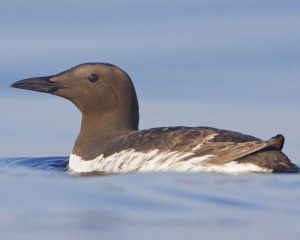
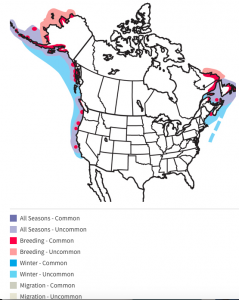

I love the humour in this post! Very entertaining 🙂 I haven’t seen one while birding. What locations are good if I want to see a Common Murre on Van Isle?
-Christina
Hey Christina!
So I’ve yet to see a Common Murre down on the southern end of Vancouver Island although I know it is within their range. The main place I have seen them has been on Northern Vancouver Island while out on a boat. You may have some luck doing a cruise out on the water, or keeping your eyes peeled while taking the ferry!
COMU numbers typically rise in this area as the winter progresses. In January to March, there should definitely be good numbers visible at places like Piper’s Lagoon, Neck Point, or Parksville to Qualicum Beach. Christmas Bird Counts around here usually yield many thousands.